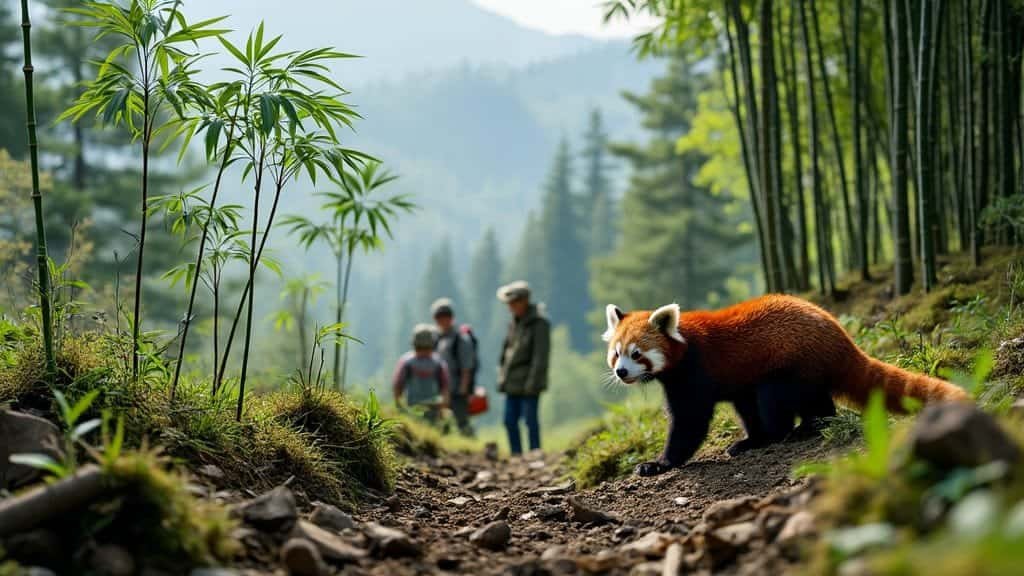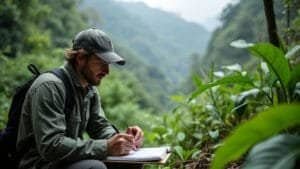Introduction
Red panda habitat restoration is critical to conserving this species, as habitat loss and fragmentation continue to threaten their survival
Ongoing research is exploring diverse methods, from bamboo replanting to climate-resilient forest management, aimed at rebuilding and preserving the mountainous bamboo forests red pandas call home
This article examines current habitat restoration projects, highlights the role of bamboo and deforestation management, and explores how local communities are involved
We’ll also discuss how these projects measure success to ensure that restored habitats support red panda population growth and biodiversity for years to come
Current Habitat Restoration Projects for Red Pandas
Ongoing habitat restoration projects focus on re-establishing red panda habitats by addressing deforestation, supporting bamboo regeneration, and creating climate-resilient forests
These initiatives are led by conservation organizations, governments, and local communities, with efforts targeting specific regions across the Eastern Himalayas
Here, we explore key organizations spearheading restoration efforts, the areas prioritized for habitat recovery, and the central role bamboo planting plays in these initiatives
Key Organizations Leading Restoration Efforts
Several organizations are actively engaged in red panda habitat restoration. The Red Panda Network, a prominent leader in red panda conservation, has established habitat restoration projects across Nepal that work closely with local communities to restore bamboo forests
Another significant organization, the World Wildlife Fund (WWF), collaborates with governments and local stakeholders to protect and replant forests in Bhutan and India. The International Union for Conservation of Nature (IUCN) also supports large-scale habitat restoration efforts, focusing on maintaining biodiversity and creating stable ecosystems for red pandas
These organizations prioritize landscape-scale restoration to connect fragmented habitats, allowing red panda populations to roam, forage, and thrive
Research by Thapa et al. (2020) found that regions with active NGO participation in restoration projects showed higher bamboo regrowth rates and improved habitat connectivity, demonstrating the impact of coordinated restoration efforts on red panda conservation
Specific Regions Targeted for Habitat Recovery
Key areas for red panda habitat restoration include the Eastern Himalayas, particularly in Nepal, Bhutan, and northeastern India. Within these regions, specific forested zones with high bamboo density are targeted, as these areas are critical for red panda foraging and shelter
For example, in Nepal, efforts are concentrated in the Kanchenjunga Conservation Area and Langtang National Park, where forest cover has declined due to deforestation and agricultural expansion
Similarly, in Bhutan, habitat restoration projects target degraded forest areas along the country’s protected park network. These efforts aim to create contiguous forests that serve as corridors between red panda populations, reducing genetic isolation and promoting healthier populations
Li et al. (2019) found that these connected areas are essential for long-term population stability, as they facilitate movement and reduce the risk of inbreeding in isolated red panda groups
Role of Bamboo Planting in Restoration Efforts
Bamboo planting is at the core of red panda habitat restoration, as bamboo makes up nearly 90% of the red panda’s diet. Habitat restoration projects focus on replanting native bamboo species, which provide both food and shelter
In many areas, bamboo growth is threatened by logging, livestock grazing, and climate change, making active replanting efforts crucial. Research by Sharma et al. (2021) highlighted that restored bamboo forests not only support red panda populations but also improve soil quality and prevent erosion in mountainous terrains
Conservationists plant different types of bamboo depending on the region, using species suited to the elevation and climate conditions of the area. In Nepal, for example, high-altitude bamboo species are replanted in mountainous regions, while lower-altitude bamboo varieties are restored in valley areas
These bamboo planting programs involve regular monitoring to ensure growth success and encourage red panda populations to return to restored areas
Bamboo planting also has wider ecological benefits, supporting the habitats of other species and contributing to biodiversity. Efforts in the Eastern Himalayas have shown that bamboo restoration can help stabilize ecosystems and provide additional resources for other herbivores, making it a foundational component of habitat restoration projects
Climate Resilience and Habitat Restoration Techniques
To ensure that restored habitats remain sustainable under changing climate conditions, many red panda habitat restoration projects focus on climate-resilient strategies
These approaches include selecting climate-adaptive bamboo species, implementing forest management techniques to counteract deforestation, and addressing the challenges of forest fragmentation
These techniques are vital to creating resilient ecosystems that can support red pandas despite increasing environmental pressures
Climate-Resilient Bamboo and Forest Management
Selecting bamboo species that can withstand fluctuating temperatures and rainfall patterns is crucial for creating stable habitats for red pandas. Conservationists are now prioritizing climate-resilient bamboo species that can thrive in both warmer and cooler environments
According to Chen and Xu (2022), specific bamboo species, such as Arundinaria maling, are better adapted to extreme temperature ranges, making them ideal for restoration in areas prone to climate instability
Planting these resilient bamboo varieties helps create more reliable food sources for red pandas, even as seasonal temperatures vary
Forest management practices that improve soil quality and water retention are also being implemented. Techniques like mulching and creating soil barriers help retain moisture during dry seasons and reduce erosion, supporting bamboo growth
In Bhutan, for instance, conservationists have begun using soil conservation techniques to improve forest health and protect bamboo stands from degradation. Such forest management practices ensure that bamboo remains abundant and accessible to red pandas even in challenging environmental conditions
Restoration Techniques Addressing Deforestation
Deforestation is a major threat to red panda habitats, and restoration projects are increasingly focusing on reforestation to rebuild lost forest cover
In areas where logging or agricultural expansion has reduced forest density, reforestation efforts aim to restore native vegetation, providing shelter and a microclimate suitable for bamboo growth
These reforestation efforts often involve planting native tree species alongside bamboo, creating a multi-layered forest structure that promotes biodiversity
Community-led reforestation initiatives are also being encouraged to protect red panda habitats from future deforestation. In Nepal, projects supported by the Red Panda Network involve training locals in sustainable forestry practices, such as selective logging and alternative fuel use, to reduce forest dependency
Thapa et al. (2020) report that these community-driven efforts have resulted in a 15% increase in forest cover in targeted areas, highlighting the positive impact of involving local populations in habitat restoration
Impact of Forest Fragmentation on Habitat Recovery
Forest fragmentation is a critical issue for red panda habitat restoration, as it limits the animals’ ability to roam and access food sources
To counteract this, conservationists are focusing on creating habitat corridors—stretches of forest that connect isolated patches of red panda habitat. These corridors allow red pandas to migrate safely between areas, supporting genetic diversity and reducing the risks of isolation
For example, in northeastern India, the WWF has been working on linking fragmented red panda habitats by reforesting corridor areas with bamboo and native vegetation
Li et al. (2019) found that habitat corridors significantly improved movement and population connectivity in red panda populations, making them an essential strategy in habitat restoration. By reconnecting fragmented forests, these projects create larger, contiguous habitats that support healthier red panda populations
By implementing climate-resilient bamboo planting, addressing deforestation, and creating habitat corridors, these restoration techniques are building sustainable ecosystems for red pandas. These strategies not only provide immediate benefits to red panda populations but also help ensure that restored habitats can withstand future environmental challenges, supporting the long-term survival of this unique species
Community Involvement in Habitat Restoration
Local communities play a vital role in the success of red panda habitat restoration. Conservation organizations increasingly work with local populations to promote sustainable practices, provide economic incentives, and involve residents in reforestation efforts
Community engagement is critical for creating long-term, sustainable solutions, as local stewardship directly contributes to the preservation and expansion of red panda habitats
Here, we examine how community partnerships, economic incentives, and successful case studies support habitat restoration for red pandas
Local Partnerships and Community-Led Initiatives
Many habitat restoration projects focus on building partnerships with local communities, recognizing that community buy-in is essential for the sustainability of these efforts
Organizations such as the Red Panda Network work closely with communities in Nepal to establish community forest groups that take active responsibility for protecting and managing local forests. These groups are trained in habitat monitoring, anti-poaching efforts, and sustainable forestry practices, empowering them to protect red panda habitats effectively
In Bhutan, community partnerships have been essential in promoting alternative livelihoods to reduce deforestation. By providing resources and training for sustainable agriculture, eco-tourism, and handicraft production, conservation organizations offer local populations ways to earn income without relying on logging or land-clearing practices
Thapa et al. (2020) found that community-led initiatives resulted in improved forest cover and reduced encroachment on red panda habitats, showing that local involvement significantly boosts restoration success
Economic Benefits of Community Involvement
Economic incentives are key to engaging communities in habitat restoration efforts. Many projects offer financial support or employment opportunities related to restoration activities, such as bamboo planting, monitoring programs, and ecotourism
In areas like eastern Nepal, locals are hired as “forest guardians” to monitor red panda habitats, track populations, and report any illegal activities that threaten the forests. This initiative provides steady income to families while ensuring continuous protection of red panda habitats
Additionally, ecotourism programs organized in collaboration with local communities offer another income source. In Nepal, the Red Panda Network has introduced red panda-focused eco-tourism, which generates revenue that goes directly back into community-led conservation and restoration efforts
According to Chen and Xu (2022), eco-tourism in red panda regions has raised local incomes by 30%, providing a powerful economic incentive to maintain red panda habitats
Success Stories from Community Participation
There are several successful examples of community involvement in red panda habitat restoration. One of the most prominent is in the Ilam district of Nepal, where locals have partnered with the Red Panda Network to restore forested areas and monitor red panda populations
The initiative has led to a measurable increase in bamboo cover and red panda sightings in restored areas, showing the effectiveness of community-driven restoration
Another success story comes from the Haa district in Bhutan, where community members have worked with the WWF to create habitat corridors that connect fragmented red panda habitats. This project has improved connectivity between red panda populations, leading to increased genetic diversity and healthier red panda communities
These success stories underscore the importance of local involvement in sustaining red panda habitats, showing that when communities are invested in habitat restoration, they help create resilient, thriving ecosystems
Community engagement is proving to be one of the most effective ways to sustain red panda habitat restoration. By fostering local stewardship, providing economic incentives, and showcasing successful collaborations, these efforts empower local populations to take an active role in protecting red pandas
Monitoring and Measuring Success in Restoration
Effective monitoring and evaluation are essential for determining the success of red panda habitat restoration efforts
These assessments help conservationists understand how restored habitats impact red panda populations, identify areas for improvement, and ensure that resources are being used efficiently
Various methods are used to measure habitat recovery, assess biodiversity, and evaluate the overall health of red panda populations in restored regions. Here, we explore the techniques used for monitoring, indicators of success, and future goals for ongoing habitat restoration projects
Methods for Evaluating Habitat Recovery
Conservationists use several methods to evaluate habitat recovery, focusing on forest density, bamboo growth rates, and the establishment of a diverse ecosystem
Remote sensing technologies, such as satellite imagery and drone mapping, allow researchers to monitor forest cover and detect changes in vegetation density over time. These tools provide valuable insights into how restored forests are expanding and whether they provide adequate coverage for red pandas
On-the-ground assessments complement remote monitoring by measuring bamboo regrowth and soil health directly. Researchers conduct regular surveys of bamboo density and monitor soil quality indicators such as moisture retention and nutrient content, both of which are critical for sustaining bamboo growth
According to Sharma et al. (2021), these surveys have shown that areas with focused bamboo restoration efforts exhibit improved soil stability, supporting healthier ecosystems for red pandas and other wildlife
Indicators of Improved Biodiversity and Red Panda Health
Indicators of biodiversity and red panda health are critical metrics in evaluating restoration success. Increased sightings and population growth of red pandas in restored areas signal that the habitats are providing suitable conditions
Red panda presence is often monitored using camera traps and GPS collars, which track movement and behavior patterns to ensure that restored areas are accessible and beneficial to the animals
Biodiversity assessments also focus on the variety of plant and animal species present in restored areas. Restoration projects often report increases in other wildlife species, including birds, small mammals, and insects, which indicate a healthy ecosystem
The study by Davis and Roberts (2023) found that restored red panda habitats saw a 20% increase in biodiversity within three years of intervention, suggesting that habitat restoration positively impacts not only red pandas but the entire ecosystem
Additionally, the health of red pandas in restored areas is monitored through veterinary checkups and health assessments of fecal samples, which provide insights into dietary diversity and overall health
Healthier red panda populations in restored habitats demonstrate that these environments are meeting the nutritional and physical needs of the species, indicating a successful restoration
Future Goals for Habitat Restoration Projects
Ongoing habitat restoration projects are setting ambitious goals to expand and improve red panda conservation efforts
One priority is to establish more habitat corridors that connect isolated red panda populations, enhancing genetic diversity and resilience against environmental changes. These corridors are essential for allowing red pandas to move freely between areas, supporting healthier and more stable populations across regions
Another future goal is to refine climate resilience strategies, ensuring that restored habitats can withstand rising temperatures and unpredictable weather. Research into drought-resistant bamboo species and forest management practices is ongoing, as these adaptations are crucial for creating sustainable red panda habitats
Conservationists are also exploring techniques to improve the genetic diversity of red panda populations by introducing individuals from other regions when feasible, bolstering the resilience of small, isolated populations
Continued community engagement remains central to future restoration goals, as community involvement has proven highly effective in maintaining restored areas. Conservation organizations aim to increase community participation, providing more local training in sustainable land management and expanding economic opportunities tied to conservation
This approach fosters a strong sense of ownership among locals, supporting long-term sustainability and providing a foundation for the continued protection of red panda habitats
By employing rigorous monitoring techniques and setting strategic goals for future projects, red panda habitat restoration efforts are paving the way for the successful conservation of this unique species
Through collaboration, innovation, and sustained community involvement, these projects contribute to creating a thriving environment where red pandas and other wildlife can flourish
Conclusion
Ongoing research into red panda habitat restoration is crucial to ensuring the survival of this endangered species. Through coordinated efforts led by conservation organizations, governments, and local communities, habitat restoration projects are focusing on replanting bamboo, establishing climate-resilient forests, and reducing the impact of deforestation and fragmentation
Key restoration strategies include planting climate-adaptive bamboo, creating habitat corridors to connect isolated populations, and involving local communities in sustainable land management practices that promote long-term preservation
Monitoring and evaluating these projects help researchers measure restoration success by tracking red panda population health, biodiversity, and vegetation recovery. Indicators such as increased sightings of red pandas, higher bamboo growth rates, and improved soil conditions demonstrate that restored habitats are making a meaningful difference
Community involvement has proven to be especially impactful, as it provides both economic benefits to locals and stewardship that fosters sustained habitat protection
Looking ahead, habitat restoration efforts will continue to prioritize climate resilience, genetic diversity, and expanded local partnerships. By setting ambitious future goals and refining restoration techniques, these projects aim to create thriving ecosystems that support red pandas and the broader biodiversity within their habitats
With ongoing research and collaboration, habitat restoration offers a hopeful path toward safeguarding red pandas for generations to come





